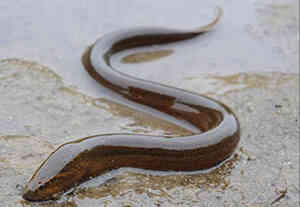
Alias Monopterus albusApodidae, Apodidae, Genus Swiftlet, eel, yellow eel, field eel, field eel, long fish, blood fish, tilapia, scaleless prince
Family Synbranchidae Monopterus
Yellow eel (scientific name: Monopterus albus): also known as eel. It is a tropical and warm temperate fish, a bottom-dwelling fish with strong adaptability. It lives at the bottom of the water body, mainly in muddy waters such as rice fields, lakes, ponds, rivers and ditches, and even in swamps, flooded fields or wetlands. It likes to live in caves. The length of the yellow eel cave is about 3 times the length of the body, and the cave is curved and crossed. Each cave usually has more than two caves. The cave exit is often close to the water surface so that it can stick its head out to breathe air.

Yellow eel likes to dig holes in humus-rich mud or live in burrows in rock crevices with water on the embankment during the day. It rarely moves during the day and goes out of its holes to look for food at night. It is nocturnal, and the skin folds in its mouth can breathe, so it can breathe air directly. In winter and dry seasons, it will dig holes 1-2 meters underground, where several fish live together. Its gills are not well developed, but it uses the inner wall of the mouth and throat as auxiliary organs for breathing, so it can breathe air directly; it can also survive when the oxygen content in the water is very poor. After coming out of the water, as long as the skin is kept moist, it will not die within a few days.
Yellow eel is a carnivorous fish that often goes out to feed at night. It can prey on various small animals, such as insects and their larvae, and can also swallow frogs, tadpoles and small fish. Yellow eel feeds mostly by sucking. Whenever it feels a small animal near its mouth, it opens its mouth and sucks. It is an omnivorous fish that feeds on various small animals. It is greedy and feeds most vigorously in summer. It can go without food for a long time in cold seasons without dying.
The diet of the eel is mainly benthic animal food, such as water earthworms, snails, tadpoles, small fish and shrimps, etc. In addition, it also eats some rotten debris, algae, melons and vegetables, etc.
The reproductive season of yellow eel is about June-August. In its individual development, it has the characteristics of male-female reversal, that is, it is female from the embryonic stage to the first sexual maturity (that is, the reproductive glands of individuals with a body length of less than 35 cm are all ovaries); after spawning, the ovaries gradually become testes; when the body length is 36-48 cm, the sex is partially reversed, and the male and female individuals are almost equal; those that grow to more than 53 cm are mostly testes. Yellow eel lays eggs near the entrance of its burrow. Before spawning, it spits out foam from its mouth to form a nest. The fertilized eggs develop on the water surface in the foam with the help of the buoyancy of the foam. Both male and female fish have the habit of protecting the nest.
It is an economical edible fish, usually sold alive. Most of the eels on the market are farmed, and most of them are farmed in the south. In Taiwan, they are mostly sliced and fried; in Chinese areas, they are regarded as blood tonics. The meat of the eel is tender and fresh. The nutritional value is very high. The eels produced from June to August are the fattest, so there is a saying among the people that "the eels in the Lesser Heat are as good as ginseng".
The eel is not only a delicacy on the table, but its meat, blood, head and skin all have certain medicinal value. According to the Compendium of Materia Medica, the eel has the effects of nourishing blood, replenishing qi, anti-inflammatory, disinfection and rheumatism. The meat of yellow eel is sweet and warm in nature. It can nourish the middle and replenish blood and treat deficiency. It is used as a folk medicine to treat cough due to deficiency, itchy body due to damp heat, hemorrhoid leakage due to intestinal wind, deafness and other symptoms. The yellow eel head is calcined into ash and taken with warm wine on an empty stomach to treat hard and painful breasts in women. Its bones are used as medicine to treat ecthyma, and the effect is quite significant. Its blood dripped into the ear can treat chronic suppurative otitis media; dripped into the nose can treat epistaxis (nosebleed); especially when used externally, it can treat facial paralysis.
The blood of yellow eel is poisonous. If eaten by mistake, it will irritate the oral cavity and digestive tract mucosa. In severe cases, it will damage the human nervous system, causing numbness of the limbs, respiratory and circulatory failure and death. Eel blood is poisonous, but the toxin is not heat-resistant and can be destroyed by gastric juice and heating. Generally, it will not cause poisoning if it is cooked. Whether the folk use of eel blood to treat diseases is due to the effect of toxins in the blood remains to be further studied.